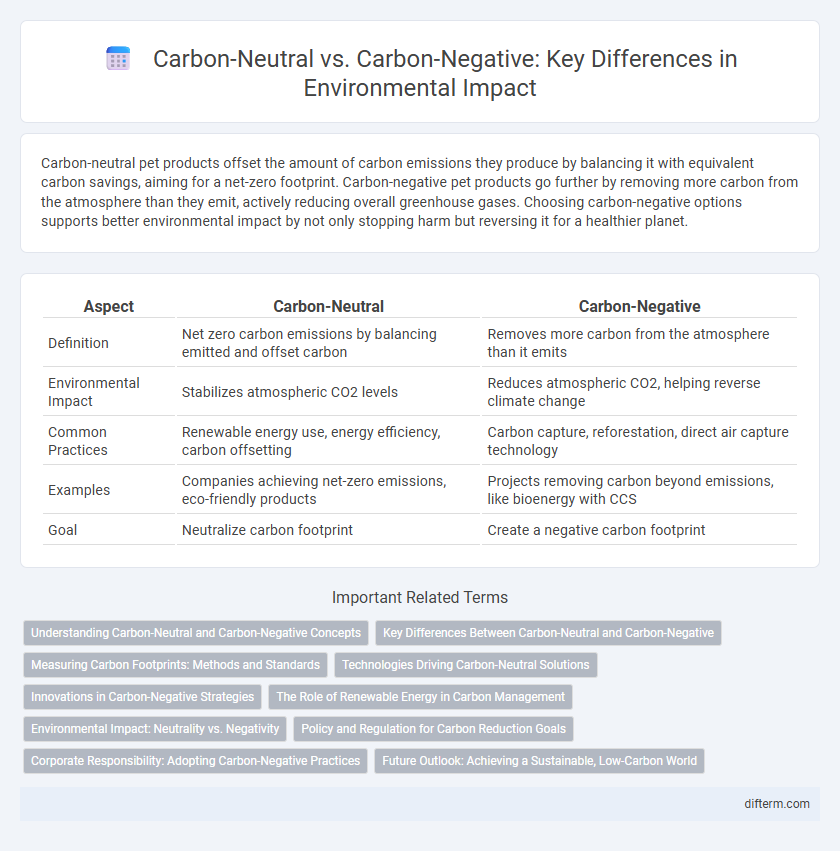Carbon-neutral pet products offset the amount of carbon emissions they produce by balancing it with equivalent carbon savings, aiming for a net-zero footprint. Carbon-negative pet products go further by removing more carbon from the atmosphere than they emit, actively reducing overall greenhouse gases. Choosing carbon-negative options supports better environmental impact by not only stopping harm but reversing it for a healthier planet.
Table of Comparison
| Aspect | Carbon-Neutral | Carbon-Negative |
|---|---|---|
| Definition | Net zero carbon emissions by balancing emitted and offset carbon | Removes more carbon from the atmosphere than it emits |
| Environmental Impact | Stabilizes atmospheric CO2 levels | Reduces atmospheric CO2, helping reverse climate change |
| Common Practices | Renewable energy use, energy efficiency, carbon offsetting | Carbon capture, reforestation, direct air capture technology |
| Examples | Companies achieving net-zero emissions, eco-friendly products | Projects removing carbon beyond emissions, like bioenergy with CCS |
| Goal | Neutralize carbon footprint | Create a negative carbon footprint |
Understanding Carbon-Neutral and Carbon-Negative Concepts
Carbon-neutral refers to balancing emitted carbon dioxide with equivalent carbon removal or offsetting to achieve net-zero emissions, essential for mitigating climate change. Carbon-negative goes beyond neutrality by removing more carbon dioxide from the atmosphere than is emitted, actively reducing overall atmospheric CO2 levels. Understanding these concepts is crucial for developing effective environmental policies and sustainable business practices.
Key Differences Between Carbon-Neutral and Carbon-Negative
Carbon-neutral refers to achieving net-zero carbon dioxide emissions by balancing emitted and offset greenhouse gases, while carbon-negative goes beyond neutrality by removing more carbon dioxide from the atmosphere than is emitted. Carbon-neutral initiatives typically involve reducing emissions and investing in carbon offsets, whereas carbon-negative strategies include advanced technologies like carbon capture and storage or enhanced reforestation efforts. The key difference lies in carbon-negative actively reducing atmospheric CO2 concentrations, contributing to a net decrease in global carbon levels.
Measuring Carbon Footprints: Methods and Standards
Measuring carbon footprints involves quantifying greenhouse gas emissions using standardized methods such as the Greenhouse Gas Protocol and ISO 14064. Carbon-neutral initiatives balance emitted carbon with equivalent offsets, while carbon-negative approaches remove more carbon dioxide from the atmosphere than they emit. Accurate assessment relies on life cycle analysis (LCA) and verified carbon accounting frameworks to ensure transparency and comparability in environmental reporting.
Technologies Driving Carbon-Neutral Solutions
Technologies driving carbon-neutral solutions include renewable energy systems such as solar, wind, and hydropower, which significantly reduce greenhouse gas emissions by replacing fossil fuels. Carbon capture and storage (CCS) and direct air capture (DAC) technologies actively remove CO2 from emission sources or the atmosphere, enhancing carbon neutrality efforts. Energy-efficient innovations in transportation, manufacturing, and building design further decrease carbon footprints, supporting sustainable development goals.
Innovations in Carbon-Negative Strategies
Innovations in carbon-negative strategies involve advanced technologies like direct air capture, bioenergy with carbon capture and storage (BECCS), and enhanced weathering, which actively remove more CO2 from the atmosphere than emitted. These cutting-edge methods offer promising solutions to mitigate climate change by achieving net-negative emissions beyond the balance targeted by carbon-neutral approaches. Enhanced investments in research and deployment of such carbon-negative innovations are critical for global efforts to limit warming to 1.5 degrees Celsius.
The Role of Renewable Energy in Carbon Management
Renewable energy plays a crucial role in achieving carbon-neutral and carbon-negative goals by significantly reducing greenhouse gas emissions from fossil fuel sources. Carbon-neutral efforts aim to balance emitted carbon with carbon removal through renewable technologies like wind, solar, and bioenergy combined with carbon capture and storage (CCS). Carbon-negative strategies go further by actively removing more CO2 from the atmosphere than is emitted, leveraging advanced renewable energy integration and negative emission technologies to restore climate balance.
Environmental Impact: Neutrality vs. Negativity
Carbon-neutral initiatives offset an equal amount of carbon emissions as they produce, resulting in no net increase in atmospheric CO2 levels and helping to stabilize global temperatures. Carbon-negative strategies actively remove more carbon dioxide from the atmosphere than they emit, reducing existing greenhouse gases and contributing to reversing climate change effects. The environmental impact of carbon-negative approaches is more profound, as they not only halt further damage but also restore ecological balance by diminishing the carbon footprint beyond zero.
Policy and Regulation for Carbon Reduction Goals
Carbon-neutral policies aim to balance carbon emissions by offsetting released CO2 through measures such as reforestation or carbon credit trading, which are often mandated by national and international regulations like the Paris Agreement. Carbon-negative regulations go further by requiring entities to remove more carbon dioxide from the atmosphere than they emit, utilizing technologies such as direct air capture and enhanced soil carbon sequestration. Effective carbon reduction frameworks incorporate strict monitoring, reporting, and verification (MRV) systems to ensure compliance with these greenhouse gas mitigation goals.
Corporate Responsibility: Adopting Carbon-Negative Practices
Corporate responsibility increasingly emphasizes carbon-negative practices, where companies not only offset their emissions but also remove additional CO2 from the atmosphere, driving significant climate impact beyond carbon neutrality. Leading corporations implement advanced carbon capture technologies, invest in reforestation projects, and support regenerative agriculture to achieve net-negative carbon footprints. This strategic shift enhances brand reputation, meets stakeholder demands for sustainability, and aligns with global climate goals under the Paris Agreement.
Future Outlook: Achieving a Sustainable, Low-Carbon World
Carbon-neutral strategies aim to balance emitted carbon with equivalent offsets, while carbon-negative approaches remove more carbon dioxide from the atmosphere than they emit. Future outlooks emphasize advancing carbon capture technologies, renewable energy adoption, and sustainable land management to transition towards a low-carbon world. Achieving these goals requires integrating innovation, robust policies, and global cooperation for measurable reductions in greenhouse gas concentrations.
Carbon-neutral vs Carbon-negative Infographic

 difterm.com
difterm.com